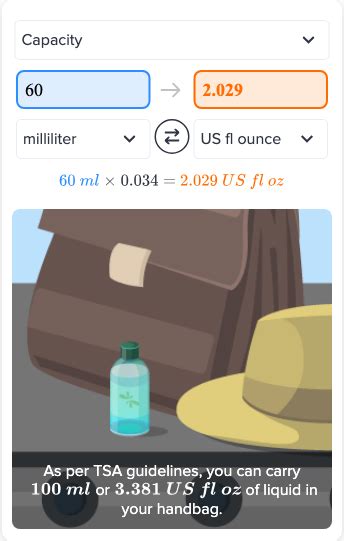60 Ml Is How Many Ounces
Kalali
Apr 03, 2025 · 4 min read

Table of Contents
60 ml is How Many Ounces? A Comprehensive Guide to Metric and Imperial Conversions
Understanding unit conversions is crucial in various aspects of life, from cooking and baking to scientific research and international trade. One common conversion that often causes confusion is converting milliliters (ml) to ounces (oz). This comprehensive guide will delve into the conversion of 60 ml to ounces, providing you with not only the answer but also a deep understanding of the process and its applications.
Understanding the Units of Measurement
Before we dive into the conversion, let's establish a clear understanding of the units involved:
-
Milliliters (ml): This is a unit of volume in the metric system. The metric system is a decimal system, meaning it's based on powers of 10, making conversions relatively straightforward. A milliliter is one-thousandth of a liter (1 ml = 0.001 L).
-
Ounces (oz): This is a unit of volume in the imperial system, predominantly used in the United States and a few other countries. The imperial system is less standardized and more complex than the metric system, making conversions sometimes more challenging. There are fluid ounces (fl oz) used for liquids and avoirdupois ounces (oz av) used for weight. In this context, we'll be focusing on fluid ounces (fl oz) which are relevant for volume measurements.
The Conversion Factor: The Key to Success
The key to accurately converting between milliliters and fluid ounces lies in the conversion factor. This factor represents the ratio between the two units. 1 fluid ounce is approximately equal to 29.5735 milliliters. This is a crucial piece of information for all our calculations.
Calculating 60 ml to Ounces
Now, let's tackle the central question: how many ounces are in 60 ml? To perform this conversion, we'll use the conversion factor:
-
Set up the equation: We'll use a simple proportion:
x oz / 60 ml = 1 oz / 29.5735 mlWhere 'x' represents the number of ounces we want to find.
-
Solve for x: To solve for x, we cross-multiply and divide:
x = (60 ml * 1 oz) / 29.5735 mlx ≈ 2.029 oz
Therefore, 60 ml is approximately equal to 2.029 fluid ounces.
Practical Applications of ml to oz Conversions
The ability to convert between milliliters and ounces is valuable in numerous real-world scenarios:
-
Cooking and Baking: Many international recipes use metric units (ml), while some measuring tools in certain countries might display measurements in ounces. Accurate conversion ensures the perfect result.
-
Medicine: Dosage instructions for liquid medications are often provided in milliliters, while some dispensing tools might use ounces. Precise conversion is critical for safe and effective medication administration.
-
Travel: When traveling internationally, you might encounter products with volume measurements in different units. Conversion allows for comparison and understanding of quantities.
-
Science and Engineering: Scientific experiments and engineering projects often involve precise measurements, requiring accurate conversion between metric and imperial units.
Beyond the Basics: Working with Different Volumes
While we've focused on converting 60 ml, the principle remains the same for other volumes. Let's explore a few more examples:
-
Converting 100 ml to ounces: Using the same conversion factor:
x = (100 ml * 1 oz) / 29.5735 mlx ≈ 3.381 oz -
Converting 250 ml to ounces:
x = (250 ml * 1 oz) / 29.5735 mlx ≈ 8.454 oz -
Converting 1 liter (1000 ml) to ounces:
x = (1000 ml * 1 oz) / 29.5735 mlx ≈ 33.814 oz
Tips for Accurate Conversion
-
Use a calculator: For precise conversions, especially with larger or more complex numbers, a calculator is highly recommended.
-
Round appropriately: When dealing with practical applications, like cooking or baking, rounding to a reasonable decimal place (e.g., one or two decimal places) is often sufficient. In scientific settings, higher precision might be necessary.
-
Double-check your work: Always verify your calculations to ensure accuracy.
Understanding the Limitations of Approximations
It's important to remember that the conversion factor of 29.5735 ml per ounce is an approximation. The exact conversion factor can vary slightly depending on the temperature and pressure of the liquid being measured. However, for most practical purposes, this approximation provides sufficient accuracy.
Advanced Conversion Techniques: Using Online Converters
While manual calculation is valuable for understanding the process, online conversion tools can streamline the process, especially for frequent conversions. These tools often provide high precision and handle various unit conversions.
Conclusion: Mastering Milliliters and Ounces
Mastering the conversion between milliliters and ounces is a valuable skill with broad applications. This guide has provided a comprehensive overview of the process, including practical examples and tips for accurate conversions. Remember to use the correct conversion factor and, when needed, round your answer to the appropriate level of precision. By understanding this essential conversion, you'll be well-equipped to handle various situations requiring the conversion of units of volume. Whether you're a cook, a scientist, a traveler, or simply someone curious about units of measurement, mastering this skill will enhance your understanding of the world around you and make a variety of tasks easier and more precise.
Latest Posts
Latest Posts
-
33 Is What Percent Of 60
Apr 06, 2025
-
How Many Inches Are In 250 Cm
Apr 06, 2025
-
How Many Miles Is 20000 Feet
Apr 06, 2025
-
What Percent Is 17 Of 25
Apr 06, 2025
-
25 Centimeters Equals How Many Inches
Apr 06, 2025
Related Post
Thank you for visiting our website which covers about 60 Ml Is How Many Ounces . We hope the information provided has been useful to you. Feel free to contact us if you have any questions or need further assistance. See you next time and don't miss to bookmark.
